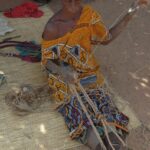The customary tassles (bukki) of a West African horse harness aren’t just for decoration. The rider takes the reins in his right hand and throws the trailing mass of bukki over his left shoulder. Although this part could be used as a whip, it is more normal for the rider to swing it in the air in a circular movement without actually touching the horse. The sound of the swooshing bukki is enough to make the horse respond.
The reins set consists of the karbajuruwol, which runs from the bit and is used for control of the horse, and a pair of boggerde, which are side reins for decorative purpose only, running from the halter (sigiwol) and looping over the pommel of the saddle.
The karbajuruwol consists of two narrow flat lengths, each plaited from 22 strands of leather, which meet in the middle to form three narrow round plaits (dorwi), then tailing off into one flat strand with tassles (bukki) on the end. The lengths are punctuated with colourful bukki and black stoppers called dokke. At either end are loops called kine (singular hinere, which literally means nostril) through which the horse’s bit is attached.
In the making, the long leather strands are plaited first (Images 1-3), incorporating the stoppers (dokke). Colour is dabbed onto the completed plaits and strips of white plastic cut from sheets bought in the market are threaded through the dokke as decoration. These strips were traditionally made from fine strips of new-born goat skin, whitened by rubbing. The bukki are made separately from leather that is cut out and dyed (Image 4), then attached with braided strips (Image 5).
Like the majority of leatherworkers in Burkina nowadays, the Gakou family uses synthetic dyes. Formerly there were just four colours available: yellow haako hojoro made from the leaves of the hojoro tree; red sokombo made from the outer leaves of a specially grown sorghum; black santala made from scrap metal dooyikiije foraged from blacksmith’s left-overs found in the bush. Synthetic green replaces the parts that were traditionally left white and pink replaces red.Today, all the dyes come as imported powders. The old ways have been left, according to one man because “you (foreigners) brought us your cheap dyes.”
Apart from black, none of the traditional dyes are colour fast, and for that reason SAHEL products do not currently incorporate them.






